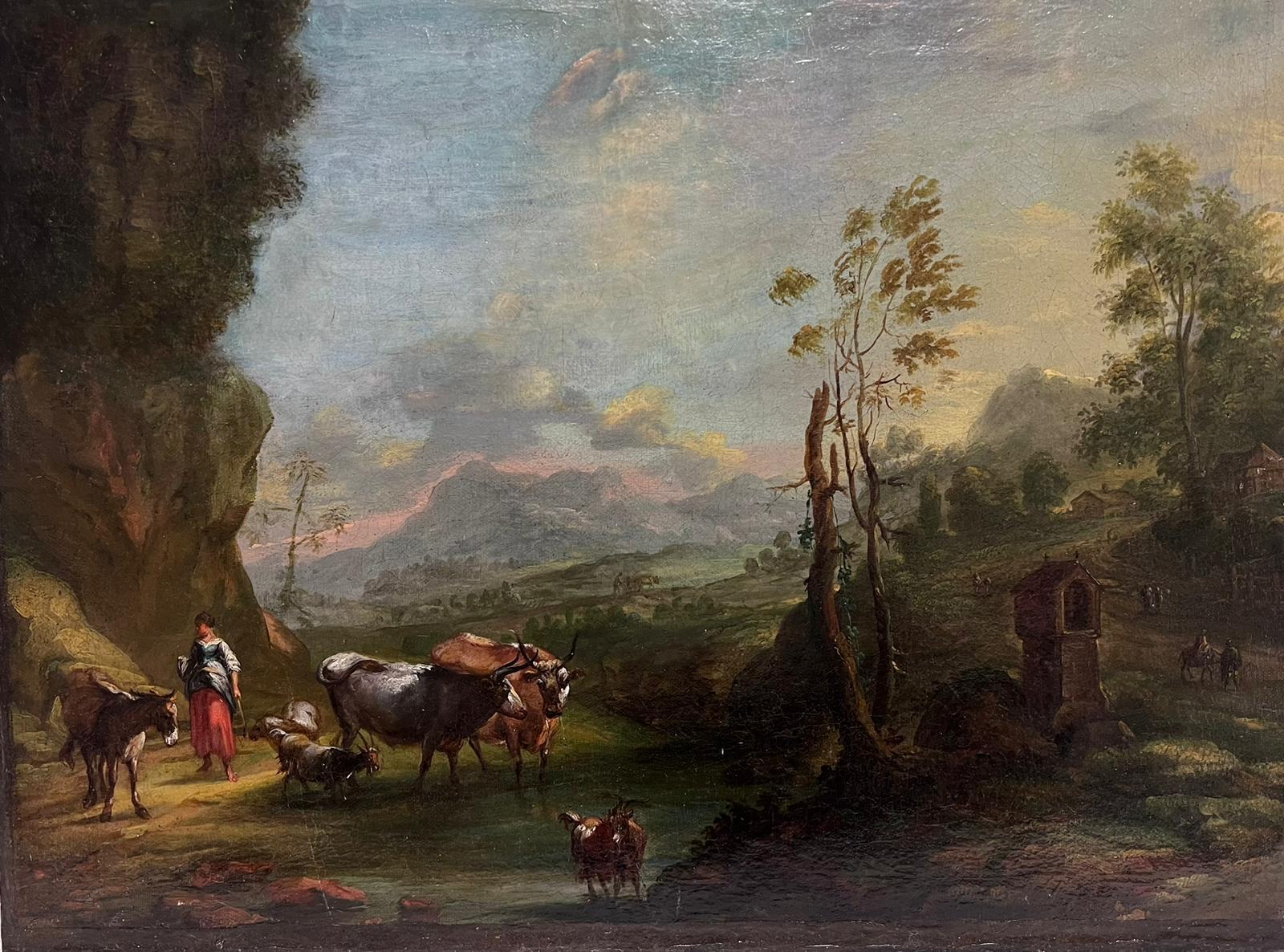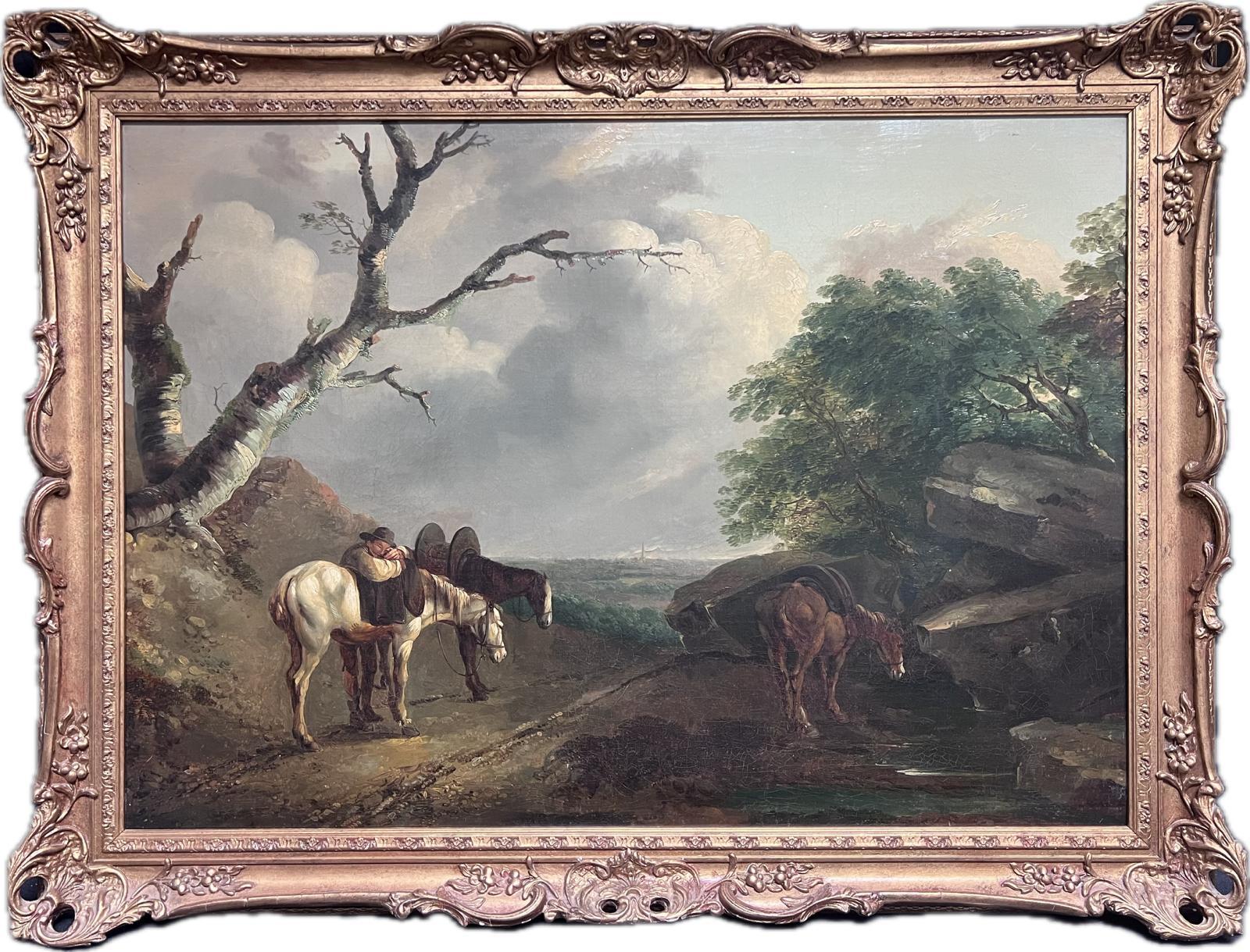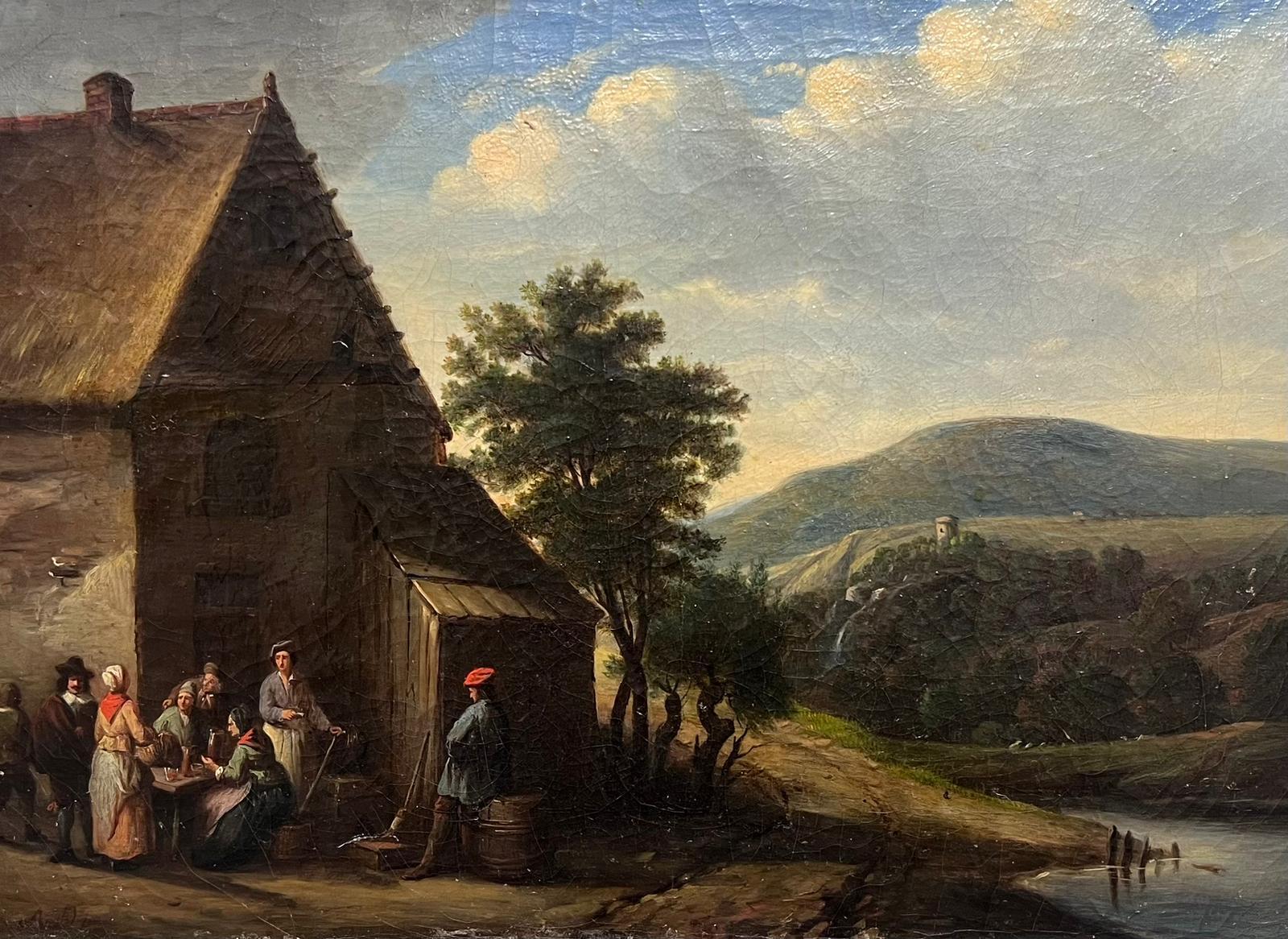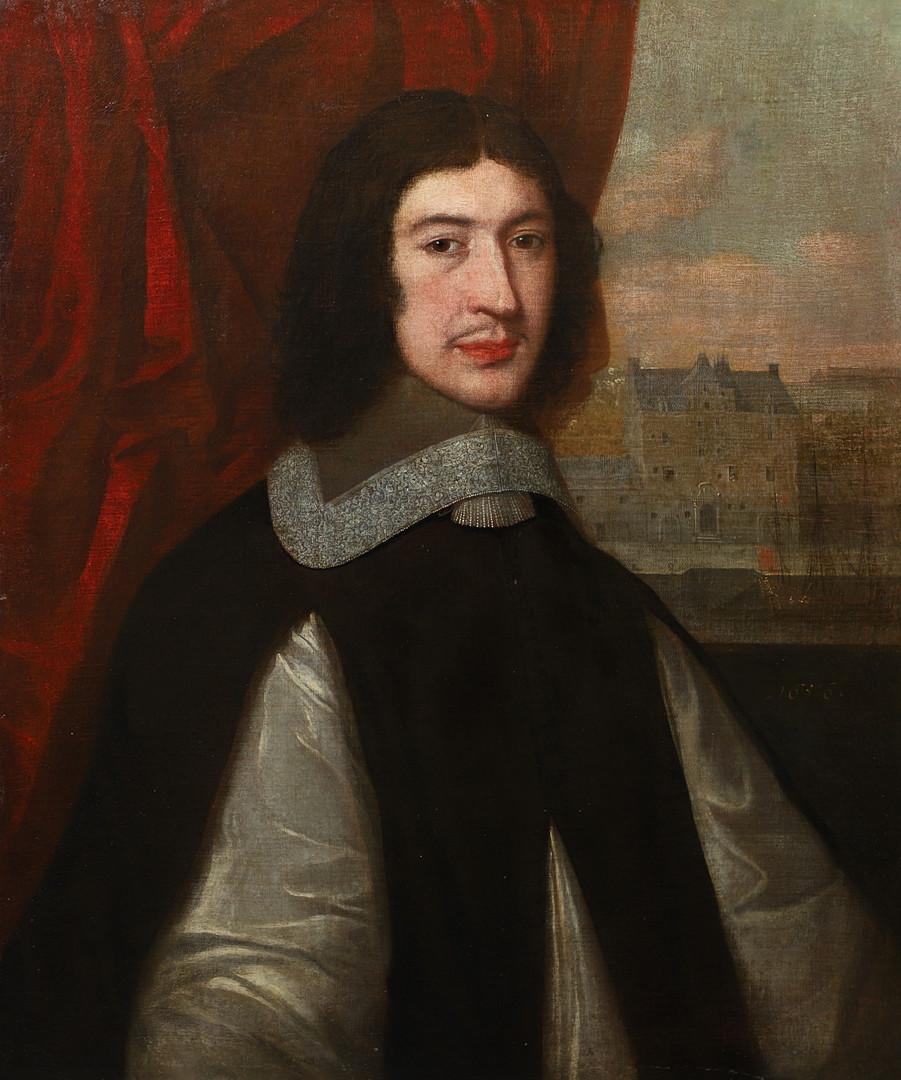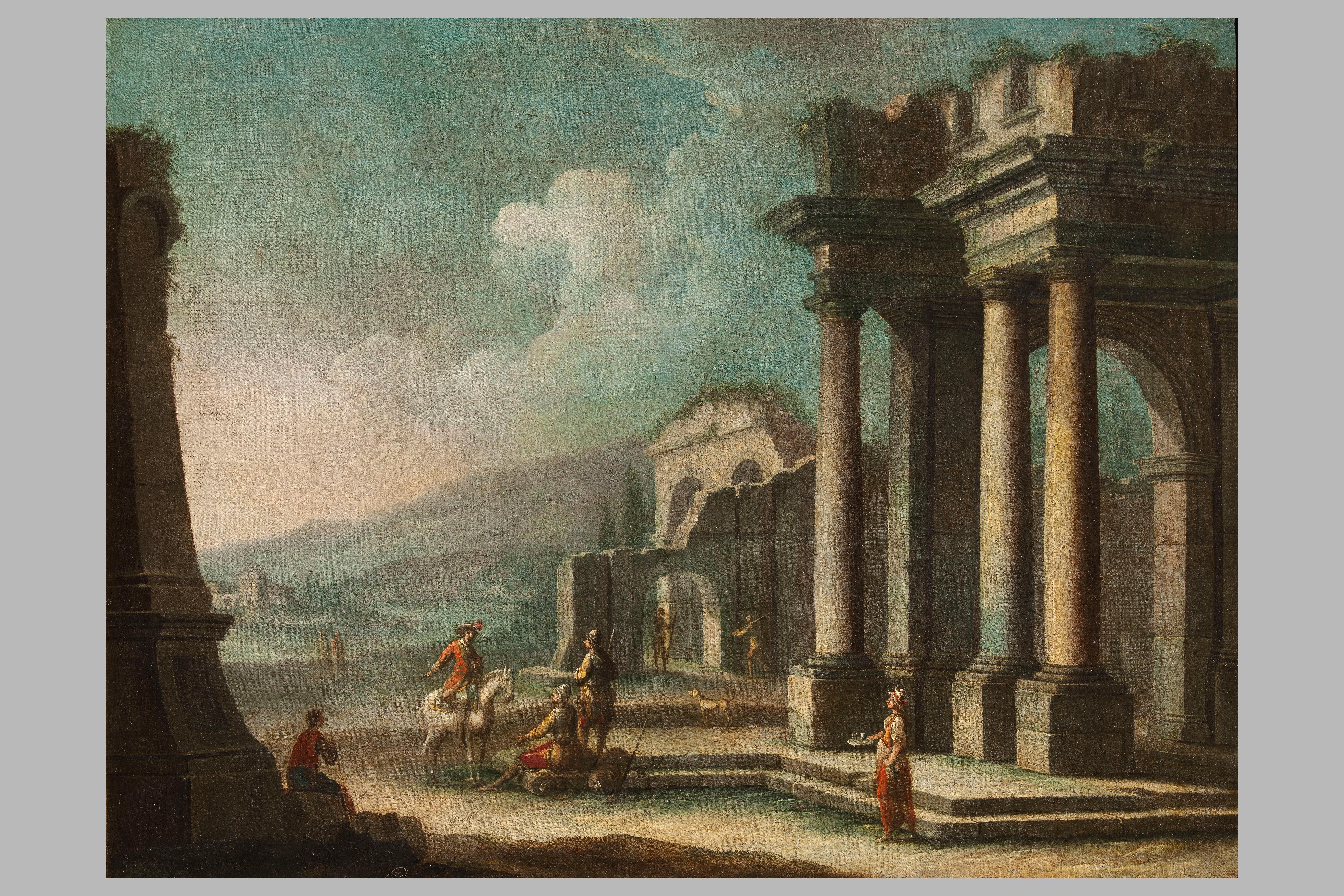Items Similar to River Landscape Village Paint oil on canvas 17th Century
Want more images or videos?
Request additional images or videos from the seller
1 of 19
UnknownRiver Landscape Village Paint oil on canvas 17th Century 1680-1720
1680-1720
About the Item
River landscape with popular life scene
Oil painting on canvas
62 x 98
Framed 74 x 110 cm.
We present this vast and harmonious composition, where a characteristic river landscape acts as a stage for an exquisite extract of popular life, set in a small village on the edge of a lush stream.
The painting, which presents characters unequivocally linked to the Flemish culture of the second half of the 17th century, shows iconographic and stylistic correspondences, in particular, with the successful production of Adrien Frans Boudewijns (1644-1711) and Pieter Bout (1658- 1719).
Aside from the figure of duck hunter along the waterway, the rest of the protagonists of the scene are confined to a pleasant family scenario, animated by many figures busy in their varied daily activities; there is the mother and grandmother who look after a newborn baby, a young man intent on watching the herd while he drinks, the old men playing and conversing around a table, another woman intent on cooking, with a dog that seems to look at her curiously.
The work is characterized by an extremely meticulous pictorial rendering, the details are portrayed with the proverbial Flemish expertise.
The painting is in excellent condition, it is accompanied by a golden frame.
The work, like all our objects, is sold accompanied by a certificate of photographic authenticity in accordance with the law.
- Creation Year:1680-1720
- Dimensions:Height: 29.14 in (74 cm)Width: 43.31 in (110 cm)
- Medium:
- Movement & Style:
- Period:
- Condition:
- Gallery Location:Riva del Garda, IT
- Reference Number:1stDibs: LU98816527742
About the Seller
4.8
Platinum Seller
These expertly vetted sellers are 1stDibs' most experienced sellers and are rated highest by our customers.
Established in 2017
1stDibs seller since 2018
202 sales on 1stDibs
Typical response time: <1 hour
- ShippingRetrieving quote...Ships From: Riva del Garda, Italy
- Return PolicyA return for this item may be initiated within 7 days of delivery.
Auctions on 1stDibs
Our timed auctions are an opportunity to bid on extraordinary design. We do not charge a Buyer's Premium and shipping is facilitated by 1stDibs and/or the seller. Plus, all auction purchases are covered by our comprehensive Buyer Protection. Learn More
More From This SellerView All
- Van Den Bossche Alexander The Great Paint Oil on canvas 17/18th Century FlemishLocated in Riva del Garda, ITBalthasar Van Den Bossche (Antwerp, 1681 - 1715) Alexander the Great and Campaspe in the studio of the painter Apelles The canvas was exhibited in Perugia (Museo di Palazzo della Pe...Category
17th Century Old Masters Paintings
MaterialsOil
- Coastal Landscape Capriccio Saeys Paint Oil on canvas 17/18th century FlemishLocated in Riva del Garda, ITJacob Ferdinand Saeys (Antwerp 1658 - Vienna 1726) and workshop Architectural capriccio with a coastal view at sunset and figures oil painting on canvas 60 x 91 cm., With frame 75 x...Category
17th Century Old Masters Paintings
MaterialsOil
- Battle Horsemen Landscape Graziani Paint Oil on canvas 17th Century Old masterLocated in Riva del Garda, ITFrancesco Graziani, known as Ciccio Napoletano (active in Naples and Rome in the second half of the 17th century) Battle with clash of horsemen Oil on canvas 95 x 130 cm In period ...Category
17th Century Old Masters Paintings
MaterialsOil
- Storm See Water Landscape Vernet 18th Century Paint Oil on canvas Old masterLocated in Riva del Garda, ITClaude-Joseph Vernet (Avignon, 1714 - Paris, 1789) workshop of The Storm on the Lighthouse 1750/60 Technique: Oil on canvas Dimensions: 48 x 67 cm / framed 77 x 93 cm We share a highly pleasing work, a splendid marine executed by a talented painter from the workshop of the Frenchman Claude-Joseph Vernet, depicting a coastal view set in a Mediterranean port with the sea still stormy. The focal point of the composition is the large lighthouse at the entrance to the port, which, due to the power of the sea, was unable to bring to safety the ship that had crashed against the rocks, while the silhouette of a second sailing ship can be glimpsed in the distance. The canvas shows in full the pictorial, chromatic and narrative characteristics of the great master Vernet's coastal landscapes, characterised by the inimitable atmospheric conditions always hovering between darkness and light, storm and calm, instilling the observer with contrasting feelings, made even more intense by a palette of vibrant and highly contrasting colours. A similar composition, from which our author must necessarily have drawn, also attributed to the workshop of Claude Joseph Vernet is to be found in France, in Nantes, at the Musée d'Arts.  The effects of the light create a visual drama in the contrast between the darkness of the rain-laden storm clouds and the gash of clear sky that is opening up, pierced by the timid rays of light. The real magic of the painting is the painter's highly personal use of light and colour, with chiaroscuro effects that accentuate its three-dimensionality and movement. The compositional typology, as well as the quality of execution and attention to detail we are dealing with, are typical elements of the 'prototypes' conceived by the master, later taken up around the middle of the 18th century by his best pupils. Similar versions can be found in the most important international museums and private collections, belonging to a large series of paintings that the master created, together with his collaborators, during his stay in Italy. Vernet lived in Rome for twenty years (1734 - 1753), becoming particularly popular with English aristocrats who stopped there on their Grand Tour. International fame followed him from Rome to France, and to his English and French clients he added German princes...Category
18th Century Old Masters Paintings
MaterialsOil
- Allegory Triumph Of Art Over Time De Visch Paint 18th Century Oil on canvas ArtLocated in Riva del Garda, ITMatthias de Visch (La Reninge, 1701 - Bruges, 1765) Signed and dated on the edge of the globe: M. De Visch 1739. Allegory of the triumph of Art over Time (Music and Astrology that c...Category
18th Century Old Masters Paintings
MaterialsOil
- Coastal Landscape See Paint Lacroix de Marseille Oil on canvas 18th Century ArtLocated in Riva del Garda, ITCoastal view at sunset with fishermen and boats Atelier of Charles François Grenier De Lacroix, called de Marseille (Marseille 1700 - Berlin 1782) Oil on canvas 50 x 62 cm. - in fra...Category
18th Century Old Masters Paintings
MaterialsOil
You May Also Like
- 17th Century by Jacob de Heusch Pair of Landscapes Oil on CanvasLocated in Milano, LombardiaDimensions: 50 x 80 cm without frame, 70 x 100 cm with frame. Gilded, carved, sculpted and chiselled wooden box frames. Publications: Jacob de Heusch (1656 – 1701). Un pittore ol...Category
17th Century Old Masters Landscape Paintings
MaterialsCanvas, Oil
- A WolfLocated in New York, NYProvenance: The Marchesi Strozzi, Palazzo Strozzi, Florence Sale, Christie’s, London, May 20, 1993, lot 315, as by Carl Borromaus Andreas Ruthart...Category
17th Century Old Masters Animal Paintings
MaterialsPaper, Canvas, Oil
- 16th Century by Cristofano Roncalli Saint Catherine of Siena Oil on CanvasLocated in Milano, LombardiaCristofano Roncalli (Pomarance 1552 - Rome 1626) Saint Catherine of Siena chooses the crown of thorns oil on wood, cm. 101,5x59.5 - with frame cm. 120x76 Shaped, carved and sculpted wooden cassetta frame, partly gilded and partly ebonized wood Expertise: Marco Ciampolini The marvellous scene that opens before our eyes is that of Christ's apparition to Saint Catherine of Siena; she must choose between a golden crown, the symbol of earthly royalty, and a crown of thorns, the symbol of virtuous Christian sacrifice. Catherine does not hesitate to choose the crown of thorns, her life in imitation of...Category
16th Century Old Masters Landscape Paintings
MaterialsCanvas, Cotton Canvas, Oil
- Claude-Joseph Vernet 18th century Old Master landscape, grand tour ItalyBy Claude-Joseph VernetLocated in Petworth, West SussexClaude-Joseph Vernet (French, 1714 – 1789) Fisherman by a cascade in a gorge Oil on canvas 22.1/4 x 25.1/2 in. (56.5 x 64.7 cm.) Provenance: The estate of the late Betty, Lady Grantchester Du Catalogue Collection #39 Christie's London, 3 Dec 1997, Lot 52 (£41,000) Claude-Joseph Vernet was the leading French landscape painter (with Hubert Robert) of the later 18th century. He achieved great celebrity with his topographical paintings and serene landscapes. He was also one of the century's most accomplished painters of tempests and moonlight scenes...Category
18th Century Old Masters Landscape Paintings
MaterialsOil, Canvas
- Early oil depicting the Great Fire of LondonLocated in London, GBThe Great Fire of London in September 1666 was one of the greatest disasters in the city’s history. The City, with its wooden houses crowded together in narrow streets, was a natural fire risk, and predictions that London would burn down became a shocking reality. The fire began in a bakery in Pudding Lane, an area near the Thames teeming with warehouses and shops full of flammable materials, such as timber, oil, coal, pitch and turpentine. Inevitably the fire spread rapidly from this area into the City. Our painting depicts the impact of the fire on those who were caught in it and creates a very dramatic impression of what the fire was like. Closer inspection reveals a scene of chaos and panic with people running out of the gates. It shows Cripplegate in the north of the City, with St Giles without Cripplegate to its left, in flames (on the site of the present day Barbican). The painting probably represents the fire on the night of Tuesday 4 September, when four-fifths of the City was burning at once, including St Paul's Cathedral. Old St Paul’s can be seen to the right of the canvas, the medieval church with its thick stone walls, was considered a place of safety, but the building was covered in wooden scaffolding as it was in the midst of being restored by the then little known architect, Christopher Wren and caught fire. Our painting seems to depict a specific moment on the Tuesday night when the lead on St Paul’s caught fire and, as the diarist John Evelyn described: ‘the stones of Paul’s flew like grenades, the melting lead running down the streets in a stream and the very pavements glowing with the firey redness, so as no horse, nor man, was able to tread on them.’ Although the loss of life was minimal, some accounts record only sixteen perished, the magnitude of the property loss was shocking – some four hundred and thirty acres, about eighty per cent of the City proper was destroyed, including over thirteen thousand houses, eighty-nine churches, and fifty-two Guild Halls. Thousands were homeless and financially ruined. The Great Fire, and the subsequent fire of 1676, which destroyed over six hundred houses south of the Thames, changed the appearance of London forever. The one constructive outcome of the Great Fire was that the plague, which had devastated the population of London since 1665, diminished greatly, due to the mass death of the plague-carrying rats in the blaze. The fire was widely reported in eyewitness accounts, newspapers, letters and diaries. Samuel Pepys recorded climbing the steeple of Barking Church from which he viewed the destroyed City: ‘the saddest sight of desolation that I ever saw.’ There was an official enquiry into the causes of the fire, petitions to the King and Lord Mayor to rebuild, new legislation and building Acts. Naturally, the fire became a dramatic and extremely popular subject for painters and engravers. A group of works relatively closely related to the present picture have been traditionally ascribed to Jan Griffier...Category
17th Century Old Masters Landscape Paintings
MaterialsCanvas, Oil
- View of Ponte Milvio in RomeLocated in Roma, RMNorthern painter active in Rome in the second half of the 17th century, View of Ponte Milvio Oil painting on canvas 73 x 97 cm in coeval Roman Salvator Rosa frame.Category
18th Century and Earlier Old Masters Landscape Paintings
MaterialsCanvas, Oil
Recently Viewed
View AllMore Ways To Browse
Art Set Canvas
Oil On Canvas River
Canvas 17th
17th Oil
Oil Painting 17th
17th Century Oil Paintings
Oil Canvas 17th Century
Old Small Oil Art
Oil On Canvas 17th Century
17th Century Oil On Canvas Painting
Old Men
Antique Golden Frames
Golden Antique Frames
Unknown Village
Oil Canvas 17th
Popular Watches
Popular Watch
River Village
